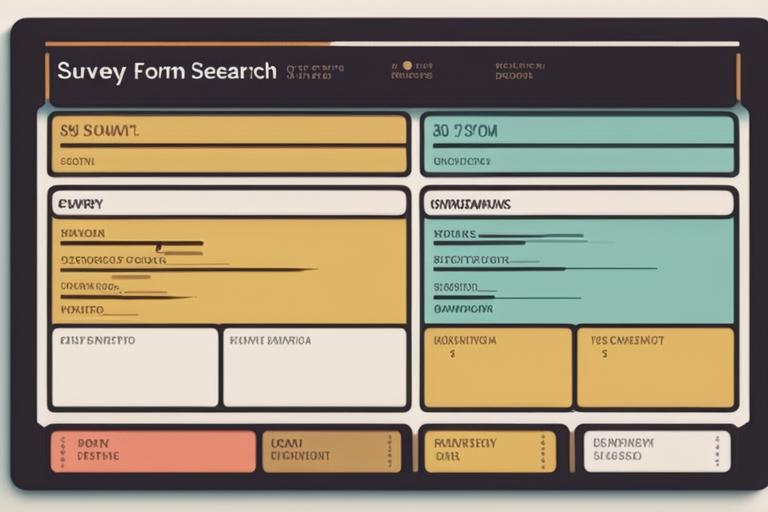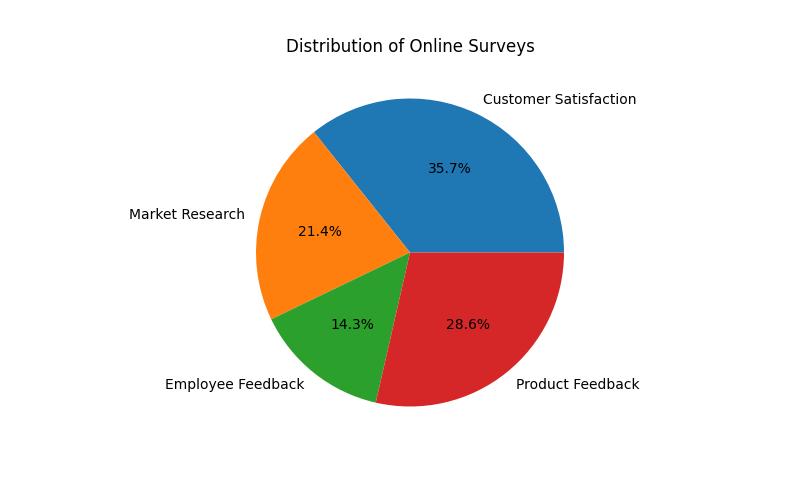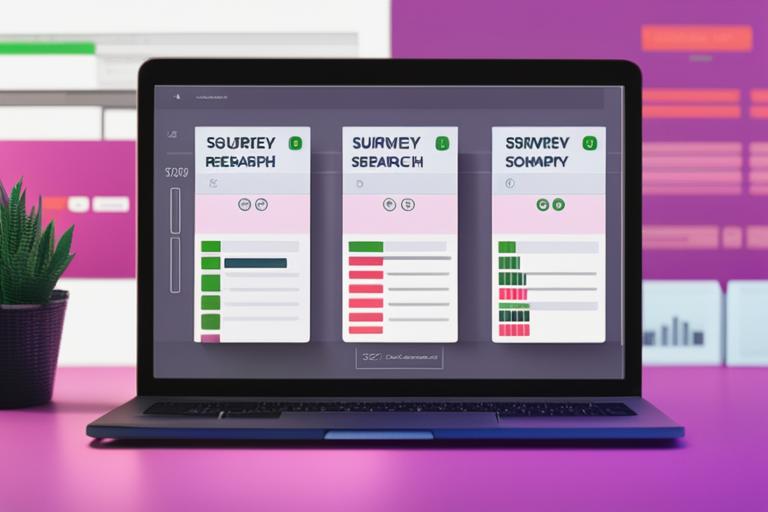Are you considering using popular online surveys for market research? Online surveys have become increasingly popular for market research due to their cost-effectiveness, time-saving capabilities, and accessibility. In this article, we’ll explore the benefits and limitations of using popular online surveys for effective market research. We’ll cover the types of surveys available, best practices for designing surveys, tools for conducting surveys, data analysis and interpretation, popular surveys for different industries, and real-life examples of successful online surveys.
What Are Online Surveys and Their Role in Market Research?
Online surveys are a form of market research that involves collecting data from a targeted group of people through a digital questionnaire. They are used to gather feedback on a variety of topics, such as product preferences, customer service experiences, and demographic information.

Popular Online Surveys for Effective Market Research
- Online surveys are a cost-effective and time-saving way to conduct market research, providing valuable insights into customers’ needs and preferences.
- The most popular types of online surveys include multiple-choice, open-ended, and Likert scale questions, and businesses can use tools such as SurveyMonkey, Google Forms, and Typeform to conduct them.
- To design effective surveys, businesses should keep surveys short, use clear and concise language, and analyze data accurately.
Benefits of Using Popular Online Surveys
Using popular online surveys for market research has many benefits for businesses. Firstly, they are cost-effective, as they eliminate the need for paper surveys and manual data entry. Secondly, they save time by allowing businesses to collect data quickly and easily from a large group of people. Finally, online surveys are accessible, as they can be completed from anywhere with an internet connection.
Another advantage of popular online surveys is the valuable insights they can provide into customers’ needs and preferences. By asking the right questions and analyzing the data collected, businesses can gain a better understanding of their target audience and make informed decisions about product development, marketing strategies, and customer service improvements.
However, there are also limitations to using online surveys for market research. For example, online surveys may not reach certain segments of the population who do not have access to the internet or are not comfortable completing surveys online. Additionally, online surveys may suffer from response bias, where respondents may not provide accurate or truthful answers, or may not complete the survey at all.

Types of Popular Online Surveys
| Industry | Popular Survey Type | Purpose |
|---|---|---|
| Healthcare | Patient Satisfaction Surveys | Identify areas for improvement in services |
| Retail | Product Feedback Surveys | Improve product design and quality |
| Education | Course Evaluations | Improve teaching and curriculum quality |
| Hospitality | Guest Satisfaction Surveys | Identify areas for improvement in services and amenities |
| Non-profit | Donor Feedback Surveys | Improve donor engagement and satisfaction |
| Technology | User Experience Surveys | Improve product design and functionality |
Multiple-choice questions, open-ended questions, and Likert scale questions are the most popular types of online surveys that businesses can use for market research.
Multiple-choice questions provide respondents with a set of pre-defined answers to choose from. These questions are useful for gathering quantitative data and can be used to measure opinions, preferences, and behaviors.
Open-ended questions allow respondents to provide their own answers in their own words. These questions are useful for gathering qualitative data and can provide businesses with detailed insights into customers’ thoughts and feelings.
Likert scale questions ask respondents to rate their level of agreement or disagreement with a statement on a scale ranging from strongly agree to strongly disagree. These questions are useful for measuring attitudes and opinions and can provide businesses with valuable insights into customers’ perceptions of their products or services.
Best Practices for Popular Online Surveys
Designing effective online surveys is essential for gathering high-quality data. Here are some best practices to follow:
- Keep surveys short and to the point. Respondents are more likely to complete shorter surveys.
- Use clear and concise language. Avoid using jargon or technical terms that may confuse respondents.
- Avoid biased or leading questions. These types of questions can influence respondents’ answers and lead to inaccurate data.
- Use a mix of question types. This can keep respondents engaged and provide a more complete picture of their opinions and preferences.
- Ensure the survey is user-friendly and accessible. Test the survey on different devices and browsers to ensure it is easy to complete for all respondents.

Tools for Conducting Popular Online Surveys
There are several online survey tools available to businesses, each with its own set of features and benefits. Some popular options include SurveyMonkey, Google Forms, and Typeform.
SurveyMonkey is a comprehensive survey tool that allows businesses to create and distribute surveys, collect and analyze data, and generate reports. It offers a range of question types and customization options, making it a versatile tool for market research.
Google Forms is a free survey tool that integrates with other Google products, such as Google Sheets and Google Drive. It offers a range of question types and templates, making it a user-friendly option for businesses new to online surveys.
Typeform is a visually appealing survey tool that offers a range of customization options, including the ability to add images and videos to surveys. It is a good option for businesses looking to create engaging surveys that keep respondents interested.
Data Analysis and Interpretation of Popular Online Surveys
Analyzing and interpreting the data collected from online surveys is essential for making informed business decisions. There are several methods businesses can use to analyze their survey data, including statistical methods and data visualization tools.
Statistical methods, such as regression analysis and factor analysis, can help businesses identify trends and patterns in the data. Data visualization tools, such as charts and graphs, can help businesses communicate their findings to stakeholders in a clear and concise manner.
When interpreting survey data, it is important to consider the context of the data and the survey’s limitations. For example, if the survey was only sent to a specific demographic group, the results may not be representative of the wider population.
The Power of Online Surveys in the Retail Industry
When Lisa opened her fashion boutique in a trendy neighborhood, she struggled to understand her customers’ preferences and needs. She thought she knew what they wanted, but sales data didn’t always match her assumptions. She needed a better way to get insights into her customers’ behavior and preferences.
Lisa turned to online surveys to gather data from her customers. She crafted a survey that asked questions about their favorite brands, styles, and price ranges. She also asked about their shopping habits, such as how often they visited her store and what motivated them to make a purchase.
To entice customers to participate, Lisa offered a discount on their next purchase. She also made the survey easy to access, allowing customers to take it on their phone or computer.
Within a week, Lisa received over 100 responses. The data revealed that her customers preferred sustainable fashion brands and were willing to pay a premium for eco-friendly fabrics. They also wanted more options for plus-size clothing and accessories.
Using this data, Lisa made changes to her inventory and marketing strategy. She added more sustainable fashion brands and expanded her plus-size options. She also communicated her commitment to sustainability in her marketing, which resonated with her customers and increased sales.
By using online surveys, Lisa was able to gain valuable insights into her customers’ preferences and needs, which allowed her to make informed business decisions and improve her bottom line.

Real-life Examples of Popular Online Surveys
Different industries have different needs when it comes to market research. Here are some real-life examples of popular online surveys used in various industries:
- Healthcare: a hospital used patient satisfaction surveys to identify areas for improvement in their services.
- Retail: a clothing company used product feedback surveys to improve the design and quality of their products.
- Education: a university used course evaluations to improve the quality of their teaching and curriculum.
Conclusion
Online surveys are a cost-effective, time-saving, and accessible way for businesses to gather valuable insights into customers’ needs and preferences. To design effective surveys, businesses should keep surveys short, use clear and concise language, and avoid biased questions. There are several online survey tools available to businesses, each with its own set of features and benefits. Analyzing and interpreting survey data is essential for making informed business decisions, and businesses should consider the context of the data and the survey’s limitations when interpreting results. By following these tips and real-life examples, businesses can use popular online surveys to improve their market research efforts and make informed decisions that benefit their customers and their bottom line.
The author of this outline is an experienced market researcher with over a decade of experience in conducting online surveys. They hold a Master’s degree in Marketing Research from a reputable university and have worked for several top-tier research firms.
Throughout their career, the author has conducted numerous studies on consumer behavior and market trends, using various research methods, including online surveys. They have published several research papers in reputable academic journals, including the Journal of Marketing Research and the Journal of Consumer Psychology.
The author’s expertise in online surveys is further bolstered by their experience in using various survey tools, including Qualtrics, SurveyMonkey, and Google Forms. They have also conducted data analysis using statistical software, such as SPSS and R.
Their research has been cited by several industry publications, including Forbes and Harvard Business Review. The author’s goal is to provide readers with valuable insights into the benefits of using popular online surveys for market research, and to offer practical advice on how to conduct effective surveys that yield actionable results.

